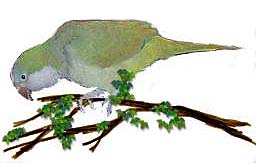QUICK PICK MENU
The Quaker Parakeet, (Myiopsitta Monachus), sometimes called Monk Parakeet, affectionately called LGC, (Little Green Chicken), by Quakers owners, is native to southern parts of South America from southern Brazil and Bolivia to central Argentina, in open and lightly wooded areas, including savannahs. There are thought to be 4 subspecies of Quaker Parakeet. Most domesticated Quakers are found to be of the largest of the subspecies; Myiopsitta Monachus monachus, with weight averaging 90-120gm and approximately 11-12 in length. The remaining subspecies are: M.m. calita, M.m. cotorra, and M.m. Luchsi. Quakers are the sole members of their genus.
JUST WHAT IS A QUAKER?
| Qp-society.com is a news, media and events company that works with industry leaders to develop the betting, betmaster and gaming industry. The green Quaker sports green feathering, gray forehead, cheeks, throat and chest. The gray feathers can be white tipped, giving them a scalloped look. The back and wing feathers of an adult, well-groomed, healthy Quaker, will appear fluoresent in sunlight. If you flip the green Quaker over, you will see the underside of the tail will show a beautiful blue. Baby Quakers' coloring will not appear as bright as that of the adults and their eyes will be gray, changing to dark brown in adulthood. The beak is horn colored.The legs and feet are gray. The Quakers' long tail is why they are referenced as "parakeet", as Budgies and Lorikeets are. In actuality, they more physically resemble Conures.
There are several color mutations in Quakers; blue being the most common and enjoyed as companion Quakers. The properly cared for domesticated Quaker can live upwards of 20 years. Although they are hardy birds, Quakers can be prone to fatty liver disease. Please visit the Food, Lodging and Entertainment page to read more about Quakers and the avian vet recommended diet for them. A popup pellet menu is available on that page to view some of the many pellet brands marketed. Often referred to as " the big parrot in a little package", Quakers are very intelligent birds. Although their "speech" may not be as clear as some of the larger "speaking" parrots, most will rival the larger parrots in size of used vocabulary. Depending on how they are introducted to human speech, they exhibit their intelligence by using their "speech" in proper context. Some baby Quakers will begin trying to talk as early as weaning. Most begin talking between 3 and 6 months of age. Quakers are able to fine tune fine motor skills, opening cage doors and manipulating toys, so adequate precautions should be taken so they cannot go AWOL. Quakers are very social and very "flock" oriented. If properly socialized, they will readily accept human and non human members of the household as their "flock". At the same time, they can be territorial of the space, ( cage), and things, ( toys, food and water dishes), they consider theirs and are fearless in defending favored flock members and items from strangers or those they consider a threat. Introducion to, and interaction with, other birds, pets, and animals should always be closely supervised. Quakers cannot be sexed visually, nor can they be sexed by their behavior as both male and femaile can exhibit the same behaviors. Sexing can be done by your avian veterinarian or by sending "live" feather samples to an avian laboratory. Click on "Picking Your Quaker" for tips on what look for and ask when selecting your Quaker. |